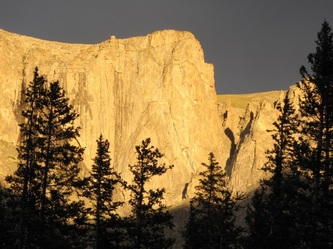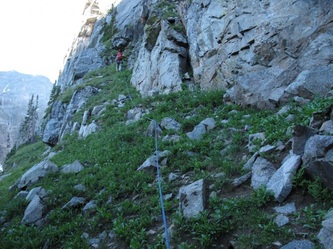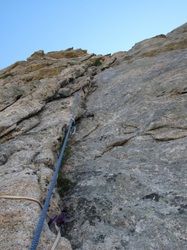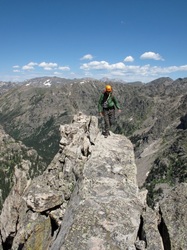Lone Eagle via North Face (5.7)
August 11-12, 2011
Part 2 - Alone on the Eagle
a.k.a. Having an Extra Large Day
This is a continuation of Part 1 - The Tofflesan
Part 2 - Alone on the Eagle
a.k.a. Having an Extra Large Day
This is a continuation of Part 1 - The Tofflesan
Prologue:
Wanting to continue my end-of-summer hiking spree, I had saved a special plan for last. My buddy Glen and I had knocked out some classic routes (Crestones, North Buttress to Traverse - Longs, Keyhole Ridge - Spearhead, North Ridge, The Bastille, Rewritten) and had thought hard about what would be next.
Some of the classics...
Some of the classics...
Lone Eagle
For those who have never set eyes on Lone Eagle in person, there are not many ways to describe it. It often appears in dramatic photos of Colorado's mountains and always seems to be too surreal to truly exist. It resides deep in the Indian Peaks and the shortest hike to see it is about 7 miles (one-way). From Crater Lake at its base, Lone Eagle soars into the sky and manages to dwarf all of its much larger neighbors. The summit tapers to a tiny point 1,700 feet above the lake and seems like an impossible target to reach.
In reality, Lone Eagle is not a true peak itself. It is simply the dramatic finish of a narrow ridgeline that starts on Mount George and extends down past the reclusive Iroquois. The standard route to the summit is a tricky path that tests your ability to remain cool while you descend then ascend highly exposed class 4 ledges. It is aptly named Solo Flight and is considered by many to be one of the hardest "easiest" routes to a summit in the Indian Peaks. My first experience with Lone Eagle was on Solo Flight about 4 years ago and the final push turned me around. My friends who I watched make the summit returned shaken and weary. I've always referred to it as my summit that got away and have been waiting for the right time to return.
Flying High
Setting our sights on Lone Eagle, we decided to go for the classic north face. First ascended by the Stettner brothers, the route climbs up the sheer face directly above Crater Lake. Rated a modest 5.7, the climb is 11 pitches long and alternates between easy stretches and tricky climbing. As Roach says in his Indian Peaks guide, "It is a serious rock climb in a remote setting and you should approach it with the proper skills polished and ready. If you don't know what the proper skills are, then stay away from this route."
Glen picked me up at noon and we made the long drive to the Monarch Lake trailhead south of Grand Lake. The hike in was long and my legs could tell that it was my fourth day climbing in a row. We finally rolled into Crater Lake around 7pm and set up camp as the weather threatened thunder and rain. The route was in full view from below and we both had a mix of excitement and nerves. The climbing looked much harder than rated from below and it was a daunting sight. We joked about expecting to hear deep drums (think Lord of the Rings) coming from the peak during the night.
Morning came quickly and with a perfect forecast we enjoyed being able to cook breakfast and drink coffee. We left camp about 7 and made for the rock. The opening pitch was damp and alternated between rock, grass and trees.
Pitches 2-4 was an ascending traverse up an easy (class 2-3 with one spot of 5.0) ramp covered with trees and brush. The thistles reminded us this was an alpine climb whenever we put our hand in one. We simul-climbed this entire section and set up a belay below a steepening chimney system (simul-climbing is dangerous!)
Pitch 5 lead up to into the chimney (5.5) and pitch 6 was the routes first crux (5.5+) to get on grassy ledges above the chimney. Loose rocks were everywhere and we had to be careful not to knock them down on each other.
Above the chimney we simul-climbed pitches 7 and 8 up alternating class 2 grass and low 5th class rock steps. I was amazed to see marmots living up on the cliffs and wondered how they got there. We belayed the final awkward 5.4 step to the top small gully we were and found ourselves below the crux pitch.
Pitch 9 was a class 3 ascent to move the belay below P10. The 5.7 crux looked steep and fun. It started with a steep traverse into an even steeper crack system. The climbing was very reminiscent of Eldo crack pitches and after pulling some slightly overhanging moves I began to run out of gear. Stopping about 100 feet up, I brought up Glen and he quickly lead the last half of the crux. The exposure opened the higher we got and we both agreed this would be terrifying for somebody just breaking into leading 5.7 trad.
Above the crux, we moved the belay and lead up the final pitch taking the variation right on the edge of the face (5.6). The summit came quickly and was an amazing perch. The views in all directions were spectacular and the exposure was astonishing.
After soaking it in, we coiled the rope and headed down Solo Flight. The initial downclimb was easier than I expected and we soon we traversing the lower shelf. We missed the 3rd-4th class upclimb and ended up soloing low 5th class back up to the ridge (oops). Happy to be back on easy terrain, we quickly made it back down to the lake.
I peered back up the face while pumping water and wondered if anybody camping at the lake had seen us climbing. We reluctantly packed and made for the car. Lone Eagle soon disappeared from view and reminded us of how far in we had to go to even see it. It had been an amazing climb. Definitely a classic route on one of the most striking peaks in Colorado.
Glen picked me up at noon and we made the long drive to the Monarch Lake trailhead south of Grand Lake. The hike in was long and my legs could tell that it was my fourth day climbing in a row. We finally rolled into Crater Lake around 7pm and set up camp as the weather threatened thunder and rain. The route was in full view from below and we both had a mix of excitement and nerves. The climbing looked much harder than rated from below and it was a daunting sight. We joked about expecting to hear deep drums (think Lord of the Rings) coming from the peak during the night.
Morning came quickly and with a perfect forecast we enjoyed being able to cook breakfast and drink coffee. We left camp about 7 and made for the rock. The opening pitch was damp and alternated between rock, grass and trees.
Pitches 2-4 was an ascending traverse up an easy (class 2-3 with one spot of 5.0) ramp covered with trees and brush. The thistles reminded us this was an alpine climb whenever we put our hand in one. We simul-climbed this entire section and set up a belay below a steepening chimney system (simul-climbing is dangerous!)
Pitch 5 lead up to into the chimney (5.5) and pitch 6 was the routes first crux (5.5+) to get on grassy ledges above the chimney. Loose rocks were everywhere and we had to be careful not to knock them down on each other.
Above the chimney we simul-climbed pitches 7 and 8 up alternating class 2 grass and low 5th class rock steps. I was amazed to see marmots living up on the cliffs and wondered how they got there. We belayed the final awkward 5.4 step to the top small gully we were and found ourselves below the crux pitch.
Pitch 9 was a class 3 ascent to move the belay below P10. The 5.7 crux looked steep and fun. It started with a steep traverse into an even steeper crack system. The climbing was very reminiscent of Eldo crack pitches and after pulling some slightly overhanging moves I began to run out of gear. Stopping about 100 feet up, I brought up Glen and he quickly lead the last half of the crux. The exposure opened the higher we got and we both agreed this would be terrifying for somebody just breaking into leading 5.7 trad.
Above the crux, we moved the belay and lead up the final pitch taking the variation right on the edge of the face (5.6). The summit came quickly and was an amazing perch. The views in all directions were spectacular and the exposure was astonishing.
After soaking it in, we coiled the rope and headed down Solo Flight. The initial downclimb was easier than I expected and we soon we traversing the lower shelf. We missed the 3rd-4th class upclimb and ended up soloing low 5th class back up to the ridge (oops). Happy to be back on easy terrain, we quickly made it back down to the lake.
I peered back up the face while pumping water and wondered if anybody camping at the lake had seen us climbing. We reluctantly packed and made for the car. Lone Eagle soon disappeared from view and reminded us of how far in we had to go to even see it. It had been an amazing climb. Definitely a classic route on one of the most striking peaks in Colorado.
Note: All the photos from Lone Eagle are taking by Glen. My poor camera crapped out on the way plus all his photos are better anyway. Thanks Glen!


































